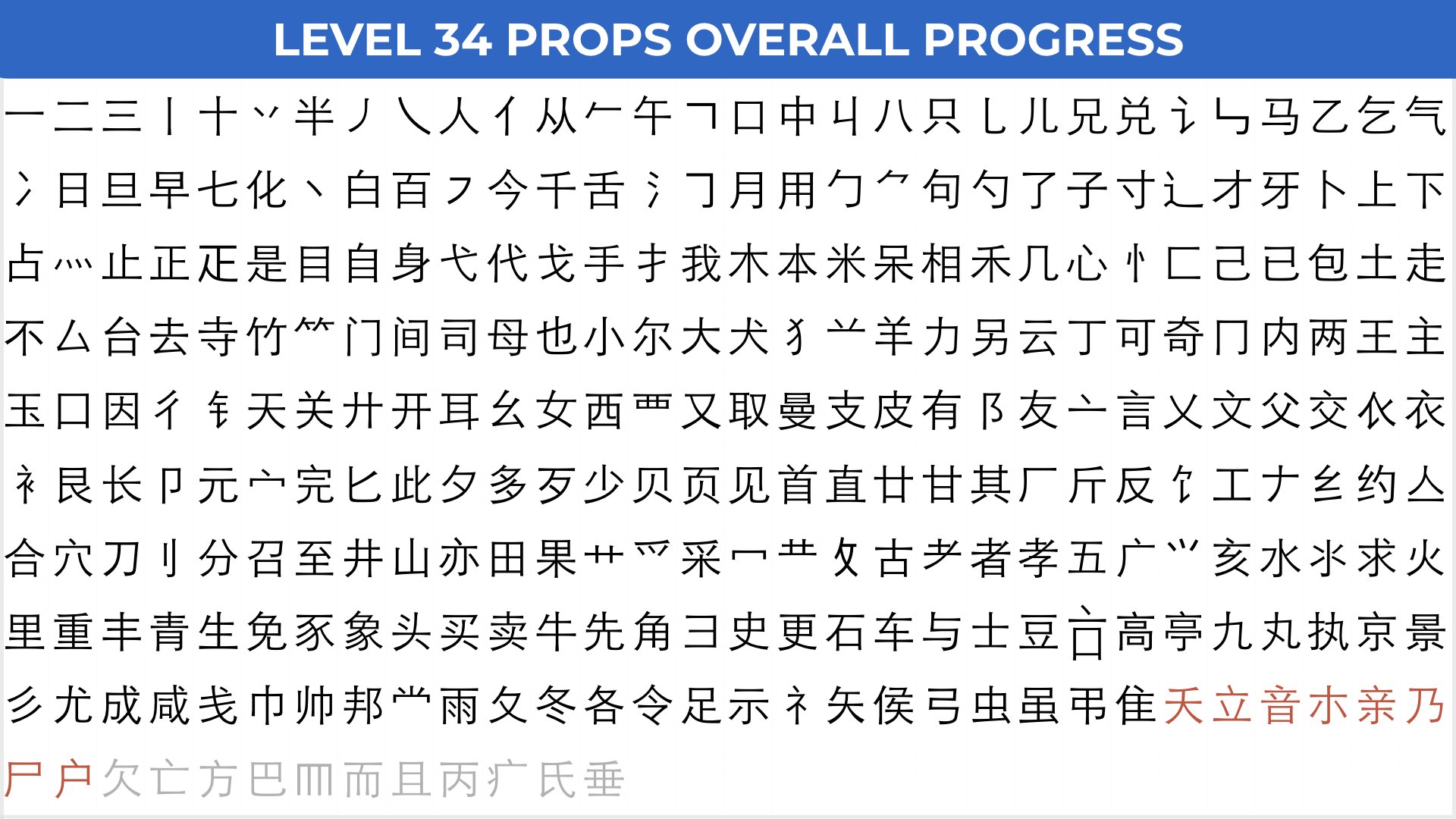Level 34 Complete
Click Here to See Your Overall Character & Word Learning Progress
(The text from this lesson is also sent to your email after you click "lesson complete." If you didn't receive the email, it may be because you have email notifications turned off. Here's a video on how to update your email settings.)
所有到Level 35的学生都觉得Mandarin Blueprint是地球上最好的汉语课程 (kèchéng - curriculum).
Wow wow wow! 哇!(wà - wow!) Can you believe you’ve come this far?
Let’s Talk 多音字
Is it 乐 lè or 乐 yuè? 长 cháng or 长 zhǎng? 只 zhǐ or 只 zhī?
A frequent question we receive is “Wait, so this character has more than one pronunciation?! How often does this happen?! OH NOOOOOO!!!!!!”
Don’t fret. A 多音字 is a “multiple 多 sound/pronunciation 音 character 字” (isn’t Chinese easy?). Here are some facts about them:
-
About 20% of all characters in the top-3000 have alternate pronunciations.
-
The vast majority of the alternate pronunciations are *far less frequent* than the primary pronunciation.
-
The alternate pronunciations also have alternative meanings (with a few exceptions, e.g., 谁 shéi or shuí both mean “who”).
-
Context clarifies which pronunciation to use.
Some of you might ask, “But Luke and Phil if characters sometimes have alternate pronunciations, why didn’t we learn that when we first learned the character?”
Good question! It all comes back to your foundational knowledge. Let’s use 着 as an example to illustrate what we mean:
Pronunciation #1: zhe5 (very frequent)
Meaning: (particle indicating present action)
我在站着.
I am standing.
Pronunciation #2: zháo (not all that frequent)
Meaning: (used as a complement to another verb) hit the mark; succeed in.
他的那杯牛奶我找着了。
I (successfully) found his glass of milk.
Pronunciation #3: zhuó (not at all frequent)
Meaning: to apply (e.g., pressure, thought) or to come in contact with.
Note: Rarely used alone in daily life, but in the somewhat common word 着想 zhuóxiǎng - to consider (the interests of somebody or something).
她是为你着想才劝quàn你不去的。
She advised (劝) against your going for your own good.
You can probably already see why we wouldn’t bother you with zháo & zhuó when you first learned 着. In the case of zháo, you probably already noticed that it’s almost the same as 到. People will say 找到 far more often than they’ll say 找着.
Think about it, if your foundational knowledge already includes how to use V + 到, how hard is it to learn that V + 着 zháo means practically the same thing? Secondly, “找着了” is clearly *not* the grammatical context for 着 zhe. How could you have a current action (着 zhe) that’s also a completed action (了)? Your *foundational knowledge* tells you it must be 着 zháo.
In the case of 着 zhuó, consider that out of all of the HSK vocabulary levels 1-6, 着 is only pronounced zhuó once in the word 着想, which is an HSK 6 word. Does anybody think that you ought to learn an HSK 6 word when your level is only around HSK 2?
If you try to learn alternate pronunciations too early, you lack the foundation to acquire them accurately. It’s just noise that distracts you from what you should focus on at your current level. As we’re sure you get by now, learning isn’t only about what you learn but also when you learn it.
来得及 - 来不及
In the article we wrote on Affixes, we discussed infixes in Chinese. There are only two:
Verb - 得 - Result - Verb CAN Achieve Result
Verb - 不 - Result - Verb CAN’T Achieve Result
For example, the first affix non-native speakers learn is 听不懂, aka “Listening CAN’T Achieve Understanding.” More examples:
看得懂中文
Looking (Reading) CAN achieve an understanding of Chinese
看不见他 (看不到他)
Looking CAN’T achieve seeing him
办得了 liǎo
Managing CAN be possible
Oh hey, look at that 多音字
“了” is pronounced 'le' or 'liǎo.' 了 le is clearly SUPER high frequency, but you’ll also see it come up in this “Verb - 得/不 - 了 liǎo” construction. It’s easy to understand; it just means ‘possible’ if after 得 or ‘impossible’ if after 不.
接不了球
Impossible to catch the ball
我的车上周开不了,现在开得了了。
Last week my car wouldn’t run, but it runs now.
你来得了来不了?
Will you be able to come or not?
Speaking of 来 + 得/不 + RESULT, why does the result 及 specifically relate to time? The word 及时 helps explain.
及时 is either an adjective meaning ‘timely’:
她今天来得很及时。
Her coming today is timely.
Or, more commonly, as an adverb meaning “promptly; without delay;”:
因为奶奶的朋友及时发现了奶奶的声音有点儿问题,所以医生才能救得了奶奶。
The doctor was only able to save grandma because her friend promptly discovered that something was wrong with grandma’s voice.
因为…Reason, 所以…Response to Reason
You’ll use this construction of “因为…,所以…” all the time. Note, however, that it’s not exactly something we’d do in English. We tend to imply the “so.”
English example:
Because she never arrived, I went home.
We don’t say “so I went home,” but in Chinese, you can.
因为她没到,所以我回家了。
We’re sure you can see just how useful this will be in explaining your actions to others. As always, use this grammar point to notice the 因为…, 所以... construction while inputting, not as a filter to your speech. If you notice it enough times, you won’t need to force it into what you output; it will happen naturally.










